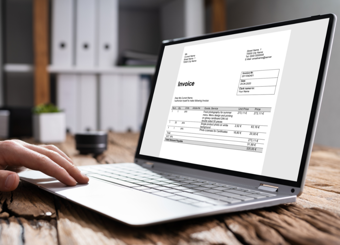Preventing Check Fraud with Digital Payment Processing
In a financial landscape where agility and security are paramount, the persistent threat of check fraud looms large, presenting not just a challenge but a significant risk to businesses of all sizes. With a staggering $815 million lost to check fraud in the U.S. in 2022 alone, it’s clear that traditional transaction methods are no longer just inefficient—they’re a liability. This evolving threat affects not only a company's bottom line but also its reputation and operational integrity.
In this blog, we explore the critical role of digital payment processing as not just a solution, but a necessary evolution in safeguarding your business’s financial transactions. We’ll discuss how embracing digital methods can fortify your defenses against fraud, enhance operational efficiency, and position your business at the forefront of financial security.
The Rising Trend of Check Fraud
Check fraud, a deceptive practice involving the unauthorized use or fabrication of checks, poses a significant threat to the financial security of businesses. It can manifest in various forms, from forging signatures and altering check amounts to creating counterfeit checks or stealing checks for fraudulent purposes. The impact of such fraud on a business is multifaceted: it can lead to direct financial loss, undermine the trust of clients and partners, and consume valuable time and resources in addressing and resolving fraudulent activities.
The alarming rise in check fraud incidences is a pressing concern. In 2022, the U.S. saw a sharp 84% increase in check fraud, totaling a loss of $815 million. This uptick is despite the overall decline in check usage, indicating that checks in circulation are increasingly targeted by fraudsters. In fact, over 680,000 instances of check fraud were reported by banks in just a single year, underscoring the vulnerability of businesses still relying on this traditional form of payment.
This significant rise in check fraud not only highlights the evolving tactics of fraudsters but also signals the urgent need for businesses to reassess their transaction methods and adopt more secure alternatives.
Digital Payment Processing: A More Secure Option
The inherent risks associated with traditional checks are numerous and significant. Checks, as physical documents, are vulnerable to a wide range of fraudulent activities. They can be easily intercepted, altered, forged, or even replicated as counterfeit checks. The manual process of handling checks further increases the risk of human error and oversight, making them an even more attractive target for fraudsters. The lag in processing time for checks also creates a window of opportunity for fraudulent activities to go undetected, often until it's too late.
On the other hand, digital payment processing offers a robust solution to these vulnerabilities. By transitioning to digital methods, businesses can leverage advanced security features that are simply not available with paper checks. Digital payments are encrypted and often require multi-factor authentication, significantly reducing the risk of unauthorized access and fraud. The immediacy of digital transactions also means that payments are processed and verified in real-time, leaving little room for fraudulent interference.
Digital payment systems also often come with sophisticated monitoring and alert capabilities, enabling businesses to quickly detect and respond to any suspicious activities. This level of security and oversight is unparalleled in the realm of traditional check processing, making digital payment processing not just an alternative, but a necessary evolution in business financial practices.
Benefits of Adopting Digital Payments
The transition to digital payments is gaining momentum, with 82% of American consumers now preferring these methods for their enhanced security and convenience. This preference is rooted in a range of tangible benefits that digital payments bring to businesses, which include but are not limited to:
Digital payments utilize advanced security protocols like encryption and multi-factor authentication, significantly reducing the risk of fraud. Real-time transaction processing and alerts help quickly identify and mitigate fraudulent activities.
Digital payment systems streamline the entire transaction process, reducing the time and resources spent on manual check processing and reconciliation. This efficiency can lead to quicker payment cycles and improved cash flow management.
Transitioning to digital payments can reduce operational costs. By minimizing the need for physical checks, businesses save on printing, mailing, and processing costs. Additionally, the reduced risk of fraud and errors translates into financial savings.
Digital payments provide a clear, accessible record of all transactions. This transparency is invaluable for audit purposes, ensuring compliance and simplifying financial reporting.
Offering digital payment options can enhance the payment experience for customers and vendors. It provides convenience, faster transaction processing, and improved satisfaction due to the ease and reliability of the process.
Identifying and Preventing Check Fraud
The ability to identify check fraud relies on awareness and vigilance. Recognizing the red flags of check fraud is the first step in prevention. Common indicators include discrepancies in check numbers, altered amounts, or unusual transactions. Businesses should consistently monitor their financial activities, keeping an eye out for any anomalies. Regular reviews of financial statements and transaction histories are essential practices in spotting unauthorized activities early. This proactive approach to identifying red flags can significantly mitigate the risk of check fraud.
Preventing check fraud involves a combination of internal policy enhancements and the adoption of technological solutions. Strengthening internal controls, such as implementing segregation of duties and conducting regular audits, is vital in minimizing internal fraud risks. Educating employees about the risks and signs of check fraud, and ensuring adherence to established security procedures, forms another layer of defense. Moreover, utilizing fraud detection tools like positive pay and automated fraud detection systems can provide an additional safeguard against external threats.
Digital payment systems play a pivotal role in both identifying and preventing check fraud. These systems offer advanced security features that are not possible with traditional checks. The shift from paper-based to digital transactions not only enhances the security of financial operations but also provides detailed audit trails, which are invaluable in tracking and preventing fraudulent activities. By integrating digital payment solutions, businesses can significantly enhance their overall security, making their financial processes both more efficient and secure.
Medius's Role in Combating Check Fraud
Medius stands at the forefront of combating check fraud with its advanced Fraud Risk and Detection platform, a comprehensive solution that integrates digital payment processing with robust fraud prevention technology. This platform is designed to provide real-time monitoring and detection, equipped with automated algorithms to identify anomalies and alert businesses to suspicious activities. By integrating digital payment methods into their core fraud prevention strategy, Medius offers a dual advantage: enhanced transaction security and streamlined financial operations, effectively reducing the risks associated with traditional check processing.
In addition to offering advanced technological solutions, Medius also contributes valuable insights into fraud prevention through resources like the Medius Financial Census on Fraud and the Accounts Deceivable podcast. These resources underscore the critical need for businesses to transition from risk-prone traditional methods to secure, digital solutions.
Medius’s approach goes beyond just providing tools; it encompasses educating clients on best practices in financial security, ensuring that businesses are not only equipped with top-tier fraud detection capabilities but are also knowledgeable in maintaining a secure financial environment.
Embracing Innovation: The Path to Safer Transactions
As we've explored in this blog, the rise of check fraud presents a clear and present danger to businesses, highlighting the limitations and risks of traditional payment methods. From the vulnerability of paper checks to the sophisticated tactics employed by fraudsters, the need for more secure transaction methods has never been more evident. Digital payment processing emerges as an effective solution, offering enhanced security, operational efficiency, and cost-effectiveness. With features like real-time monitoring, encryption, and automated fraud detection, digital payment systems are not just a choice but a necessity for businesses seeking to protect themselves in an increasingly digital world.
It's time to take action and safeguard your business. Embrace the innovation and security offered by digital payment processing. Medius’s Fraud Risk and Detection solutions provide the advanced protection and peace of mind your business needs to thrive in a world where financial security is paramount. Don’t wait for fraud to find you—be proactive and transform your financial transactions today.
Secure your business's future with Medius. Let us help you step into a world of safer, more efficient financial transactions.





